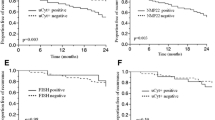Abstract
Bladder carcinoma is an important worldwide health problem. Both cystoscopy and urine cytology used in detecting bladder cancer suffer from drawbacks where cystoscopy is an invasive method and urine cytology shows low sensitivity in low grade tumors. This study validates easier and less time-consuming techniques to evaluate the value of combined use of angiogenin and clusterin in comparison and combination with voided urine cytology in the detection of bladder cancer patients. This study includes malignant (bladder cancer patients, n = 50), benign (n = 20) and healthy (n = 20) groups. The studied groups were subjected to cystoscopic examination, detection of bilharzial antibodies, urine cytology, and estimation of urinary angiogenin and clusterin by ELISA. The overall sensitivity and specificity were 66 and 75 % for angiogenin, 70 and 82.5 % for clusterin and 46 and 80 % for voided urine cytology. Combined sensitivity of voided urine cytology with the two studied biomarkers was 88 % which is higher than the combined sensitivity of both markers alone (82 %) and that of the cytology with each marker (76 and 80 %) for angiogenin and clusterin respectively. In conclusion, combined use of the cytology with the studied biomarkers can improve the sensitivity for detecting bladder cancer, and may be very useful in monitoring the effectiveness of antiangiogenic and apoptotic therapies in bladder cancer.




Similar content being viewed by others
References
American Cancer Society (2013) Cancer facts and figures 2013. American Cancer Society, Atlanta
Zaghloul S (2012) Bladder cancer and schistosomiasis. J Egypt Natl Cancer Inst 24:151–159
Eissa S, Shabayek M, Ismail M, Abd-Elateef A (2010) Diagnostic evaluation of apoptosis inhibitory gene and tissue inhibitor matrix metalloproteinase-2 in patients with bladder cancer. IUBMB Life 62(5):394–399
Urquidi V, Goodison S, Kim J, Chang M, Dai Y, Rosser CJ (2012) Vascular enothelail growth factor, carbonic anhydrase 9, and angiogenin as urinary biomarkers for bladder cancer detection. Urology 79(5):1185.e1–1185.e6
Mitra A (2010) Urine cytologic analysis: special techniques for bladder cancer detection. In: Connection. 169–177
Yafi A, Brimo F, Auger M, Aprikian A, Tanguay S, Kassouf W (2013) Is the performance of urinary cytology as high as reported historically? A contemporary analysis in the detection and surveillance of bladder cancer. Urol Oncol Semin Orig Investig 32(1):27.e1–6.
Budman L, Kassouf W, Steinberg JR (2008) Biomarkers for detection and surveillance of bladder cancer. Can Urol Assoc J 2:212–221
Li S, Hu G (2010) Angiogenin-mediated rRNA transcription in cancer and neurodegeneration. Int J Biochem Mol Biol 1(1):26–35
Eissa S, Swellam M, Labib RA, El-Zayat T, El Ahmady O (2009) A panel of angiogenic factors for early bladder cancer detection: enzyme immunoassay and Western blot. J Urol 181(3):1353–1360
Hazzaa M, Elashry M, Afifi K (2010) Clusterin as a diagnostic and prognostic marker for transitional cell carcinoma of the bladder. Pathol Oncol Res 16(1):101–109
Miyake H, Hara I, Gleave M, Eto H (2004) Protection of androgen dependent human prostate cancer cells from oxidative stressinduced DNA damage by overexpression of clusterin and its modulation by androgen. Prostate 61:318–323
American Joint Committee on Cancer (2010) AJCC cancer staging manual. Urinary bladder, 7th edn. Springer, New York, pp 497–502
Felix AS, Soliman AS, Khaled H, Zaghloul MS, Banerjee M, El-Baradie M (2008) The changing patterns of bladder cancer in Egypt over the past 26 years. Cancer Causes Control 19(4):421–429
Zheng YL, Amr S, Saleh DA, Dash C, Ezzat S, Mikhail NN, Gouda I, Loay I, Hifnawy T, Abdel-Hamid M, Khaled H, Wolpert B, Abdel-Aziz MA, Loffredo CA (2012) Urinary bladder cancer risk factors in Egypt: a multicenter case–control study. Cancer Epidemiol Biomark Prev 21(3):537–546
Salem HK, Mahfouz S (2012) Changing patterns (age, incidence, and pathologic types) of schistosoma-associated bladder cancer in Egypt in the past decade. Urology 79(2):379–383
Ahmedin J, Ram CT, Taylor M, Asma G, Alicia S, Elizabeth W, Eric JF, Michael JT (2004) American Cancer Society. Bladder Cancer J Clin 96:54–56
Burger M, Catto JW, Dalbagni G, Grossman HB, Herr H, Karakiewicz P, Kassouf W, Kiemeney LA, La Vecchia C, Shariat S, Lotan Y (2013) Epidemiology and risk factors of urothelial bladder cancer. Eur Urol 63(2):234–241
Gho YS et al (2002) Antiplasmin activity of a peptide that binds to the receptor-binding site of angiogenin. J Biol Chem 277(12):9690–9694
Yang Y, Sun M, Wang L, Jiao B (2013) HIFs, angiogenesis, and cancer. J Cell Biochem 114:967–974
Wong P, Ulyanova T, Organisciak D, Bennett S, Lakins J, Arnold JM, Kutty RK, Tenniswood M, vanVeen T, Darrow RM, Chader G (2001) Expression of multiple forms of clusterin during light-induced retinal degeneration. Curr Eye Res 23:157–165
Trougakso I, So A, Jansen B, Gleave ME, Gonos ES (2004) Silencing expression of the clusterin/apolipoprotein J gene in human cancer cells using small interfering RNA induces spontaneous apoptosis, reduced growth ability, and cell sensitization to genotoxic and oxidative stress. Cancer Res 64:1834–1842
Leskov K, Klokov D, Li J, Boothman DA (2003) Synthesis and functional analyses of nuclear clusterin, a cell death protein. J Biol Chem 278:11590–11600
Stejskal D, Fiala R (2006) Evaluation of serum and urine clusterin as a potential tumor marker for urinary bladder cancer. Neoplasma 53(4):343–346
Kim N, Yoo J, Han J (2012) Human nuclear clusterin mediates apoptosis by interacting with bcl-xl through c-terminal coiled coil domain. J Cell Physiol 227:1157–1167
Krüger S, Mahnken A, Kausch I, Feller AC (2006) Value of clusterin immunoreactivity as a predictive factor in muscle-invasive urothelial bladder carcinoma. Urology 67(1):105–109
Author information
Authors and Affiliations
Corresponding author
Rights and permissions
About this article
Cite this article
Shabayek, M.I., Sayed, O.M., Attaia, H.A. et al. Diagnostic Evaluation of Urinary Angiogenin (ANG) and Clusterin (CLU) as Biomarker for Bladder Cancer. Pathol. Oncol. Res. 20, 859–866 (2014). https://doi.org/10.1007/s12253-014-9765-y
Received:
Accepted:
Published:
Issue Date:
DOI: https://doi.org/10.1007/s12253-014-9765-y




